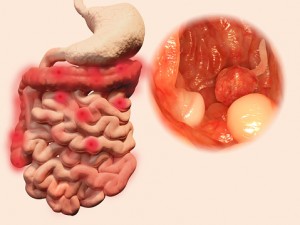What you can expect
Multimedia
Gastric bypass and other types of weight-loss surgery are done in the hospital. General anesthesia is used for weight-loss surgery. This means you're unconscious during the procedure.
The specifics of your surgery depend on your individual situation, the type of weight-loss surgery you have, and the hospital's or doctor's practices. Some weight-loss surgeries are done with traditional large, or open, incisions in your abdomen. Today, most types of bariatric surgery are performed laparoscopically. A laparoscope is a small, tubular instrument with a camera attached. The laparoscope is inserted through small incisions in the abdomen. The tiny camera on the tip of the laparoscope allows the surgeon to see and operate inside your abdomen without making the traditional large incisions. Laparoscopic surgery can make your recovery faster and shorter, but it's not suitable for everyone.
Surgery usually takes several hours. After surgery, you awaken in a recovery room, where medical staff monitors you for any complications. Your hospital stay may last from three to five days.
Types of bariatric surgery
Each type of bariatric surgery has pros and cons. Be sure to talk to your doctor about them. Here's a look at common types of bariatric surgery:
- Roux-en-Y (roo-en-y). This is a type of gastric bypass surgery, and is the most common method of gastric bypass. This surgery is typically not reversible. It works by decreasing the amount of food you can eat at one sitting and reducing absorption of nutrients. The surgeon cuts across the top of your stomach, sealing it off from the rest of your stomach. The resulting pouch is about the size of a walnut and can hold only about an ounce of food. Normally, your stomach can hold about 3 pints of food. Then, the surgeon cuts the small intestine and sews part of it directly onto the pouch. Food then goes into this small pouch of stomach and then directly into the small intestine sewn to it. Food bypasses most of your stomach and the first section of your small intestine, and instead enters directly into the middle part of your small intestine.
- Biliopancreatic diversion with duodenal switch. This is another type of gastric bypass surgery. In this complex, multipart procedure, about 80 percent of the stomach is removed. The valve that releases food to the small intestine (the pyloric valve) remains, along with a limited portion of the small intestine that normally connects to the stomach (duodenum). The surgery bypasses the majority of the intestine by connecting the end portion of the intestine to the duodenum near the stomach (duodenal switch and biliopancreatic diversion). This surgery both limits how much you can eat and reduces the absorption of nutrients. While it's very effective, it has more risks, including malnutrition and vitamin deficiencies. It's generally used for people who have a body mass index greater than 50.
- Laparoscopic adjustable gastric banding (LAGB). In this weight-loss surgery, the surgeon positions an inflatable band around the uppermost part of the stomach. When the band is inflated, it compresses the stomach, acting like a belt that tightens. This separates the stomach into two parts, with a very small upper pouch that communicates with the rest of the stomach through a channel created by the band. The small upper pouch limits the amount of food you can eat. The band can be adjusted so that it restricts more or less food. Because of its relative simplicity, LAGB is one of more common weight-loss surgeries. However, it may lead to less weight loss than may other procedures, and you may need to have the band adjusted periodically.
- Vertical banded gastroplasty. This procedure, also called stomach stapling, divides the stomach into two parts, restricting how much food you can eat. The upper pouch is small and empties into the lower pouch — the rest of your stomach. Partly because it generally doesn't lead to adequate long-term weight loss, this weight-loss surgery isn't as popular as other types.
- Sleeve gastrectomy. A sleeve gastrectomy, also called a vertical sleeve gastrectomy, is a newer type of weight-loss surgery. The sleeve gastrectomy is actually the first part of the surgical process for a biliopancreatic diversion with duodenal switch. However, the sleeve gastrectomy portion of surgery may be all that's needed to lose sufficient weight — in some cases the second part, biliopancreatic diversion, isn't needed. With sleeve gastrectomy, the structure of your stomach is changed to be shaped like a tube, which restricts the amount of calories your body absorbs.
Which type of weight-loss surgery is best for you depends on your specific situation. Your surgeon will take many factors into account, including your body mass index, your eating habits, your health problems, any previous surgery and the risks of each procedure.
After gastric bypass
After gastric bypass and other types of weight-loss surgery, you generally won't be allowed to eat for one to two days so that your stomach and digestive system can heal. Then, you'll follow a specific diet for about 12 weeks. The diet begins with liquids only, then progresses to ground-up or soft foods, and finally to regular foods. You may have many restrictions or limits on how much and what you can eat and drink.
You'll also have frequent medical checkups to monitor your health in the first several months after weight-loss surgery. You may need laboratory testing, blood work and various exams.
You may experience changes as your body reacts to the rapid weight loss in the first three to six months after gastric bypass or other weight-loss surgery, including:
- Body aches
- Feeling tired, as if you have the flu
- Feeling cold
- Dry skin
- Hair thinning and hair loss
- Mood changes
-
The Possibly Dangerous Complications of Plant based Dieting Programs
The previous ten to fifteen years has se
-
Three Burning Fat Tactics
If you would like know the 3 fat burning secrets then you definitely c
-
These Suggestions Will Help You Lose Weight And Appear Excellent!
Contrary to what many believe, losing w
-
So you抮e an Emotional Eater
Sometimes it can抰 be helped that we have our bad days, months or
-
Fast Weight Loss Tips for Teenage Girls
So, the pizzas, burgers, French fries and sodas have done their trick?
-
How to Lose Weight with Potatoes
If you have love for potato and are also trying to lose extra weight t
- DON'T MISS
- The Weight Loss Exercises Energy Cycle
- Leptin gene therapy may be better than dieting for weight loss
- Home Exercise Equipment - Choosing the Proper Equipment For Your Workout Routine
- Artificial Sweeteners ? Yes Or No?
- Fruits and vegetables that can aid weight loss revealed
- Technology Weight Loss Putting An Online Tool To Use
- Tips For Good Posture From Weight Loss And Being Fit!
- How to Lose Weight Fast and Stay Healthy
- 31 Nutritious Breakfast Recipes To Promote Month-Long Weight Loss
- The Big Lie




